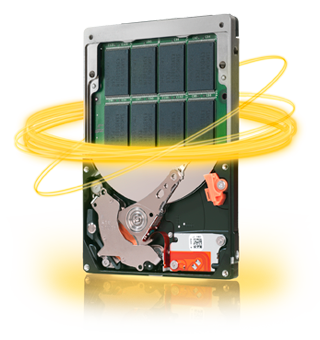Seagate Hybrid-HDD-SSD Unveiled for Notebooks
Seagate's new drive will toss your most-used data into its built-in NAND flash memory for a huge performance boost.
Last week we reported that Seagate was teasing the press with a "game changing" device that would be revealed this week. Additional reports indicated that it would be a hybrid drive that combined the capacities and low costs of a hard drive with the speed of a solid state disk. Holding true to its promise, Seagate on Monday revealed the Momentus XT drive, slated to be the fastest 2.5-inch laptop hard drive ever created.
The concept is simply awesome: merging 7200rpm platters (250 GB, 320 GB, and 500 GB) with 4 GB of SLC NAND flash. Seagate's Adaptive Memory technology combines the two by identifying patterns in how often certain digital data is used. The most frequently used data is thus moved to the solid state memory for faster access. In essence, it's tailor made to each individual user while offering a huge performance gain in return.
"We see the Momentus XT drive as a game changer, a product heralding a new generation of hard drives that combine SSD and HDD capabilities so that laptop users don’t have to make trade-offs on speed, cost or capacity," said Dave Mosley, Seagate executive vice president of Sales, Marketing and Product Line Management.
In addition to Seagate's announcement, ASUS said that it will offer the new Momentus XT drive as an upgrade option for its new Republic of Gamers (ROG) G73jh notebook. ASUS said that the drive installs as easily as a traditional 9.5-mm-high notebook drive for new systems or laptop upgrades. And unlike prior hybrid solutions, the Momentus XT operates independently of the OS and the motherboard chipset.
Now we just need a desktop model!
Check out our own review here!
Get Tom's Hardware's best news and in-depth reviews, straight to your inbox.

Kevin Parrish has over a decade of experience as a writer, editor, and product tester. His work focused on computer hardware, networking equipment, smartphones, tablets, gaming consoles, and other internet-connected devices. His work has appeared in Tom's Hardware, Tom's Guide, Maximum PC, Digital Trends, Android Authority, How-To Geek, Lifewire, and others.
-
MadAdmiral I hope they decide to increase the flash part soon. Given the 4 GB size of the flash part, I can't really see how this would make a huge real world difference. The part about identifing the most used data and automatically moving it to the flash section is very interesting. Any word on if that might/will be possible with full sized drives?Reply -
scook9 This essentially just adds another level of cache.....I am sure this could be done even better by rewriting the way that the OS uses the system memoryReply -
pharge scook9This essentially just adds another level of cache.....I am sure this could be done even better by rewriting the way that the OS uses the system memoryReply
True... but it is much easier to do it ourselves instead of pushing those big companies (MS, Apple, .....) to do what we want them to do...
If Seagate can increase the flash memory to 8G and give us the option to keep half of them for the OS start-up... it will be great.... and of course... keep the price $20 within the none-hybrid version.... -
hellwig This isn't really practical for a desktop version, where you can use more than 1 drive. The speed and storage combination are attractive for laptops (where 1 drive might be the limit), but desktop users generally have more options. A desktop user could probably store their OS on a RAID-0 setup or a small SSD for speed, and slap in a big 1TB+ drive for storage. You don't really have that option in a laptop.Reply
I worry about the detection mechanism. I mean, I only boot my computer up once a day, but I might start a separate application multiple times in a session. How will this drive know that my system DLLs are more important than my notepad.exe executable? Will it consider the amount of time taken to load the file (i.e. notepad.exe is very small and quick to load) as opposed to simply the number of times a file is accessed? -
wotan31 Like any newly released technology, there's probably some technical shortcoming in Windows that prevents it from being used. The PCtards will blame everyone except Microsoft. Meanwhile, newer, bigger, faster hardware, it's all business as usual for Linux and OSX.Reply -
Blessedman Honestly if they pushed it to 16GB, the most accessed files would end up being (well should) be OS components and would be loaded instantly. It would be extra clever if they were able to exclude pictures and movies out of the cache. That way it's not wasted on something that can wait.Reply
